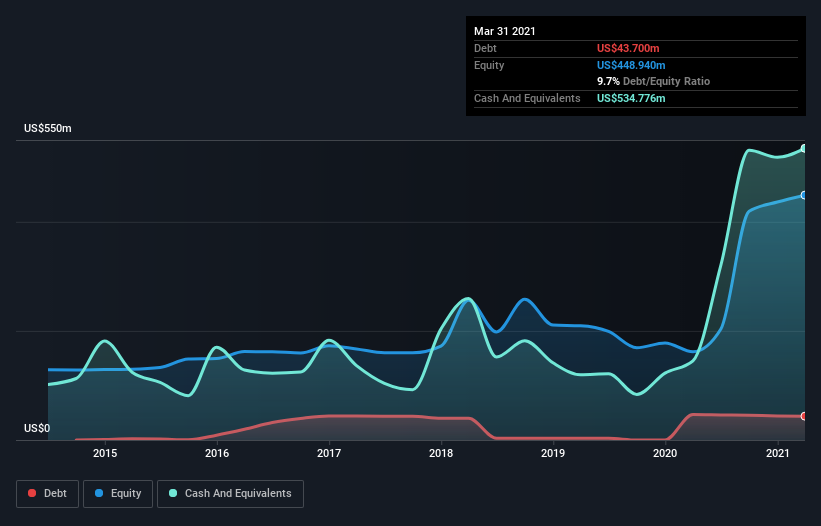Overstock.com (NASDAQ:OSTK) Could Easily Take On More Debt
David Iben put it well when he said, 'Volatility is not a risk we care about. What we care about is avoiding the permanent loss of capital.' When we think about how risky a company is, we always like to look at its use of debt, since debt overload can lead to ruin. We can see that Overstock.com, Inc. (NASDAQ:OSTK) does use debt in its business. But should shareholders be worried about its use of debt?
When Is Debt Dangerous?
Debt assists a business until the business has trouble paying it off, either with new capital or with free cash flow. Ultimately, if the company can't fulfill its legal obligations to repay debt, shareholders could walk away with nothing. However, a more usual (but still expensive) situation is where a company must dilute shareholders at a cheap share price simply to get debt under control. By replacing dilution, though, debt can be an extremely good tool for businesses that need capital to invest in growth at high rates of return. The first step when considering a company's debt levels is to consider its cash and debt together.
See our latest analysis for Overstock.com
What Is Overstock.com's Net Debt?
The image below, which you can click on for greater detail, shows that Overstock.com had debt of US$43.7m at the end of March 2021, a reduction from US$46.8m over a year. However, its balance sheet shows it holds US$534.8m in cash, so it actually has US$491.1m net cash.
How Strong Is Overstock.com's Balance Sheet?
According to the last reported balance sheet, Overstock.com had liabilities of US$370.0m due within 12 months, and liabilities of US$74.8m due beyond 12 months. Offsetting this, it had US$534.8m in cash and US$38.5m in receivables that were due within 12 months. So it actually has US$128.5m more liquid assets than total liabilities.
This surplus suggests that Overstock.com has a conservative balance sheet, and could probably eliminate its debt without much difficulty. Succinctly put, Overstock.com boasts net cash, so it's fair to say it does not have a heavy debt load!
Although Overstock.com made a loss at the EBIT level, last year, it was also good to see that it generated US$86m in EBIT over the last twelve months. When analysing debt levels, the balance sheet is the obvious place to start. But it is future earnings, more than anything, that will determine Overstock.com's ability to maintain a healthy balance sheet going forward. So if you want to see what the professionals think, you might find this free report on analyst profit forecasts to be interesting.
But our final consideration is also important, because a company cannot pay debt with paper profits; it needs cold hard cash. While Overstock.com has net cash on its balance sheet, it's still worth taking a look at its ability to convert earnings before interest and tax (EBIT) to free cash flow, to help us understand how quickly it is building (or eroding) that cash balance. Over the last year, Overstock.com actually produced more free cash flow than EBIT. That sort of strong cash generation warms our hearts like a puppy in a bumblebee suit.
Summing up
While we empathize with investors who find debt concerning, you should keep in mind that Overstock.com has net cash of US$491.1m, as well as more liquid assets than liabilities. And it impressed us with free cash flow of US$252m, being 292% of its EBIT. So is Overstock.com's debt a risk? It doesn't seem so to us. When analysing debt levels, the balance sheet is the obvious place to start. But ultimately, every company can contain risks that exist outside of the balance sheet. Be aware that Overstock.com is showing 3 warning signs in our investment analysis , you should know about...
At the end of the day, it's often better to focus on companies that are free from net debt. You can access our special list of such companies (all with a track record of profit growth). It's free.
This article by Simply Wall St is general in nature. It does not constitute a recommendation to buy or sell any stock, and does not take account of your objectives, or your financial situation. We aim to bring you long-term focused analysis driven by fundamental data. Note that our analysis may not factor in the latest price-sensitive company announcements or qualitative material. Simply Wall St has no position in any stocks mentioned.
Have feedback on this article? Concerned about the content? Get in touch with us directly. Alternatively, email editorial-team (at) simplywallst.com.

 Yahoo Finance
Yahoo Finance 
